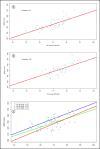A new dawn in internal medicine education curriculum-a project by the residents, with the residents, for the residents
- PMID: 36304613
- PMCID: PMC9586586
- DOI: 10.1080/08998280.2022.2109097
A new dawn in internal medicine education curriculum-a project by the residents, with the residents, for the residents
Abstract
The academic half-day (AHD) curriculum is an alternative to the noon conference (NC) approach. To date, there is little literature evaluating the transition from NC to AHD in internal medicine residency programs. We investigated the effectiveness of AHD by comparing in-training exam (ITE) and American Board of Internal Medicine (ABIM) certifying exam scores of residents before and after implementation of AHD. In 2019, we transitioned to the AHD curriculum. Averages of three consecutive years of NC (2016-2018) and AHD (2019-2021) were used for statistical testing to determine ITE and ABIM score changes. The class of 2018 experienced both approaches. Cohen's d effect sizes were calculated to assess the magnitude of change in ITE and ABIM scores between NC (2016-2018) and AHD (2019-2021) cohorts. Residents' performance significantly improved (P < 0.05) on ABIM scores (513.80 ± 48.34) on average from 2019 to 2021 compared to ABIM scores (452.42 ± 49.72) on average from 2016 to 2018 with a large effect size of 1.27. Similarly, a significant (P = 0.005) improvement in ITE scores was observed from 2019 to 2021 with implementation of AHD compared to preceding NC scores (2016-2018) with a moderate effect size of 0.52. Participating residents in AHD sessions had higher ITE and ABIM scores compared to those in hourly NC didactic sessions with significantly improved resident attendance and overall satisfaction.
Keywords: Academic half day; American Board of Internal Medicine; graduate medical education; in-training exam; noon conference.
Copyright © 2022 Baylor University Medical Center.
Figures


Similar articles
-
Transitioning from a noon conference to an academic half-day curriculum model: effect on medical knowledge acquisition and learning satisfaction.J Grad Med Educ. 2014 Mar;6(1):93-9. doi: 10.4300/JGME-D-13-00185.1. J Grad Med Educ. 2014. PMID: 24701317 Free PMC article.
-
Do USMLE steps, and ITE score predict the American Board of Internal Medicine Certifying Exam results?BMC Med Educ. 2020 Mar 18;20(1):79. doi: 10.1186/s12909-020-1974-3. BMC Med Educ. 2020. PMID: 32183789 Free PMC article.
-
Concurrent Validity Between a Shared Curriculum, the Internal Medicine In-Training Examination, and the American Board of Internal Medicine Certifying Examination.J Grad Med Educ. 2015 Mar;7(1):42-7. doi: 10.4300/JGME-D-14-00054.1. J Grad Med Educ. 2015. PMID: 26217421 Free PMC article.
-
Performance on the Cardiovascular In-Training Examination in Relation to the ABIM Cardiovascular Disease Certification Examination.J Am Coll Cardiol. 2017 Jun 13;69(23):2862-2868. doi: 10.1016/j.jacc.2017.04.020. J Am Coll Cardiol. 2017. PMID: 28595703 Review.
-
Academic Half-Day Education Experience in Post-graduate Medical Training: A Scoping Review of Characteristics and Learner Outcomes.Front Med (Lausanne). 2022 Mar 2;9:835045. doi: 10.3389/fmed.2022.835045. eCollection 2022. Front Med (Lausanne). 2022. PMID: 35308489 Free PMC article.
References
-
- AAMC . Defining the key elements of an optimal residency program. 2001. https://www.aamc.org/download/84544/data/definekeyelements.pdf.
-
- Accreditation Council for Graduate Medical Education . ACGME Program Requirements for Graduate Medical Education in Internal Medicine. 2017.
LinkOut - more resources
Full Text Sources
